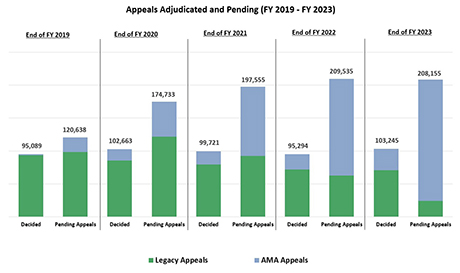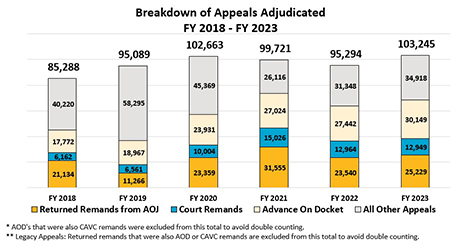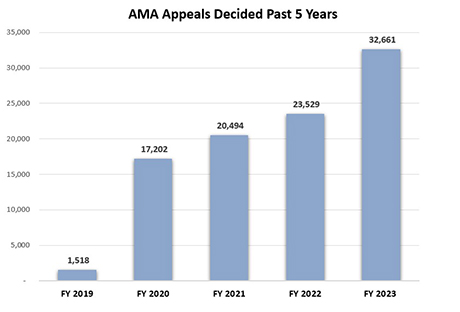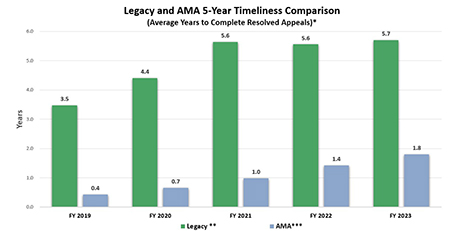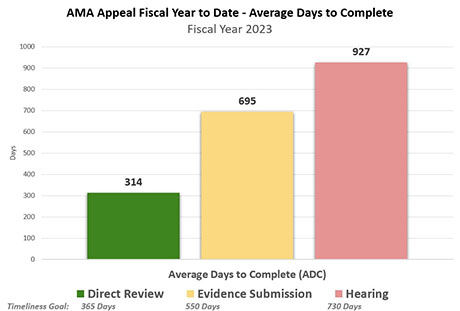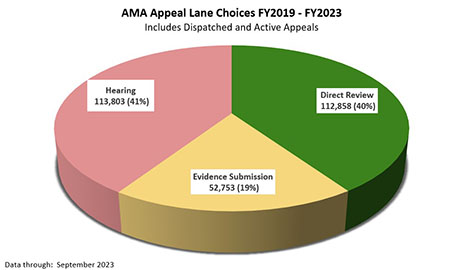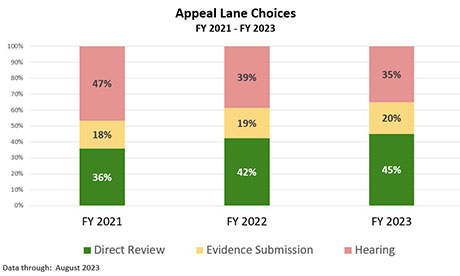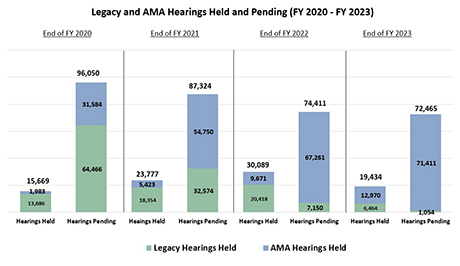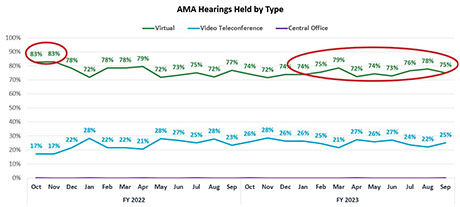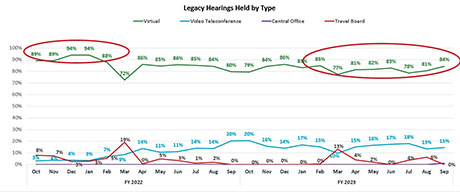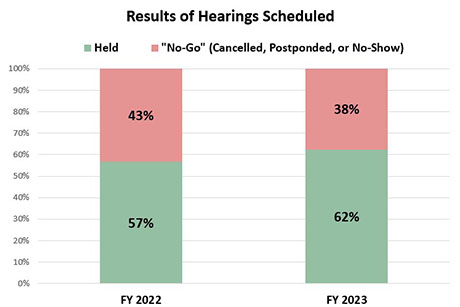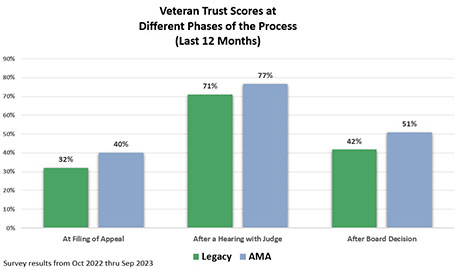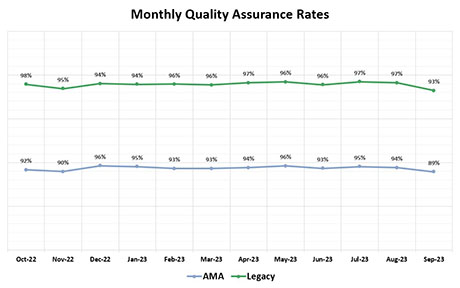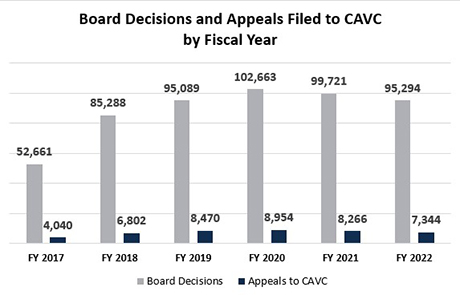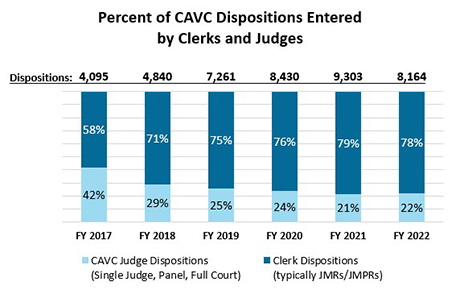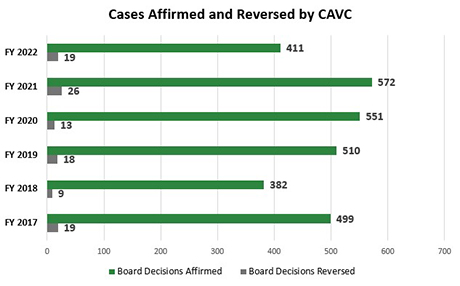Decision wait times
Workload challenges | Requirement to work cases in docket order | Complexities of two separate appeal systems | AMA appeals system shows improvements over the Legacy system | Veteran choices for types of Board appeals under the AMA necessarily influences wait times | Hearing cases generally take longer because of Judge availability | Internal review process prior to sending final decisions | Court of Appeals for Veterans Claims Review of Board Decisions
Why does my appeal at the Board of Veterans’ Appeals (Board) take so long, and what is the Board doing about it?
The Board understands that many Veterans and appellants have been waiting a long time for a decision. We acknowledge that this wait can be very frustrating and want to explain why getting a Board decision can take a long time, and what options are available to Veterans and appellants that may reduce the time they have to wait for a decision.
In recent years, the Board has resolved about 100,000 appeals each year. Despite the high numbers of decisions each year, there are still over 200,000 pending appeals waiting in line for a decision. The Board notes this is down substantially from nearly 475,000 appeals waiting for a decision just six years ago, which is significant considering the increasing number of Veterans who have filed an appeal at the Board in recent years. We have Congress to thank for providing enough resources for the Board to hire more Veterans Law Judges (VLJ), supporting counsel, and staff to help resolve and process these appeals.
The Board recognizes that each and every case has a unique set of facts and circumstances that our VLJs must carefully evaluate and appropriately resolve according to governing laws and regulations. Below is a five-year trend of workload and decided appeals.
By law, the Board must generally decide appeals in the order they are docketed (initially filed) with the Board, except for those cases advanced on the docket for extenuating circumstances set out in statute or cases returned to the Board for expedited processing after remand. More specifically, the docket order addressed in 38 U.S.C. § 7107(a)(1) and maintained by the Board must account for cases that have since been advanced on the docket, cases that receive expedited treatment on remand from the United States Court of Appeals for Veterans Claims (Court), cases that have been returned to the Board from the Agency of Original Jurisdiction (AOJ) (e.g., Veterans Benefits Administration, Veterans Health Administration) following remand, and cases that either are awaiting or have had a hearing. Overall, this means cases are generally worked on a first-come, first-served basis. For example, Legacy cases either remanded from the Court or remanded to the AOJ by the Board, maintain their original docket numbers upon return to the Board and generally must be expedited ahead of most other cases. Thousands of cases previously adjudicated by the Board are remanded and returned to the Board each year by the Court. These returned cases move ahead of other first-time appeals awaiting adjudication even though these remanded cases usually don’t result in a different outcome upon re-adjudication by the Board. As you can see below, advanced on docket cases, Court remands, and returned remands have significantly impacted the composition of the Board’s annual workload during the past three years:
As noted in the figure above, many Legacy cases have been remanded to the Board from the Court or returned to the Board by the AOJ after a prior remand from the Board. Due to the nature of those Legacy remands, which maintain their original place in line on the Board’s docket, the order of cases pending before the Board can fluctuate greatly. In other words, previously adjudicated Legacy appeals that were remanded and returned to the Board will generally be distributed for re-adjudication ahead of original appeals that have not previously been before the Board. To provide a better understanding of how this impacts how old a case may be and how that in turn impacts the priority for adjudication, roughly 15% of these remanded cases have been remanded 4 times or more and over 7% have been remanded 5 times or more. Despite this challenge, the Board remains committed to deciding the remaining Legacy appeals as expeditiously as possible.
When a Veteran files an appeal with the Board, the first thing that happens is a review of the appeal by the Board’s Intake team to make sure they have all the information they need, and then the appeal is docketed at the Board. The Board may then need to complete administrative tasks before the appeal can be worked, such as making sure we have a brief from a Veterans Service Organization or fulfilling any Privacy Act requests. Given the increasing number of appeals filed at the Board and the fact that many may require completion of an administrative task, there is a corresponding increase in the time it takes for any given appeal to come before a VLJ.
Once an appeal is eligible for review based on its place on the docket, it is assigned to a VLJ. The VLJ then assigns the case to an attorney, who reviews the entire file and drafts a decision. The draft is reviewed for legal and factual accuracy and signed by a VLJ. Many of these appeals involve multiple issues, and the claims files can have thousands of pages of evidence. The Board has a responsibility to review the entire record and write a thorough and well-supported decision; attorneys and Judges consider each appeal carefully, which is why it can take a while to get a decision in certain cases.
VA understood that the older “Legacy” claims and appeals process was slow and confusing, and, in response, worked with Congress who passed the Veteran Appeals Improvement and Modernization Act of 2017 (AMA), also known as the modernized review system. You can read the full Public Law.
This new review system offers Veterans more choice regarding the type of review they select when they disagree with a VA decision denying a benefit. In addition, the law ensures that Veterans and appellants can preserve the earliest effective date possible by continuously pursuing their claim. This means that as long as a Veteran continuously appeals their claim within the allotted time period, the effective date can go back to the first claim, if it is eventually granted. The AMA also allows Veterans and appellants to seek an additional review after a Board decision without going to the United States Court of Appeals for Veterans Claims; instead they can now file a supplemental claim with the Agency of Original jurisdiction for review of new and relevant evidence following a Board decision. For example, if a Board AMA decision denies an appealed issue, then the Veteran has an entire year to add any missing or additional evidence to their file and resubmit a supplemental claim for VA’s reconsideration. If VA then grants the appeal, the effective date can be established back to when the Veteran first filed their initial claim on that issue.
While the AMA was designed to help make the claims and appeals process less cumbersome and more efficient, there are still approximately 60,000 pending Legacy system appeals that generally represent the oldest appeals where Veterans have been waiting the longest for resolution of their appeals.
The requirement to generally decide older Legacy appeals first necessarily means it will take longer than expected for the Board to fully resolve the more recently filed AMA appeals. However, the Legacy Inventory Resolution graph below demonstrates how diligently the Board has been working to resolve the backlog of these older Legacy system appeals during the past 6 years.
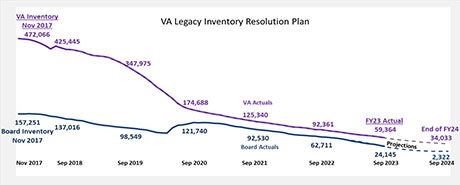
Legacy system appeals have been significantly reduced from a Department-wide high of 472,066 in November 2017 to under 60,000 pending as of the end of September 2023. VA’s pending inventory is now lower than the levels projected in the updated resolution plan but remains higher than originally projected. The initial drawdown plan was developed prior to COVID and was initially shared on October 29, 2019. The resolution plan has been updated several times with the most recent version having been issued February 2023. Each iteration incorporates historical actuals and updated assumptions to include the changing environment, workload projections, Board resources, hiring plans and various other factors that influence outcomes.
As the Legacy system cases continue to drawdown, the Board is deciding an ever-increasing number of AMA appeals each year. During the first year after AMA implementation, relatively few AMA cases were decided. Currently, approximately 40% of all decided cases are appeals filed under the AMA. The Board anticipates that the distribution percentages will correspondingly change as the number of Legacy appeals decreases and the number of AMA appeals increases. During Q3 and Q4 of FY 2023 approximately 63% of the Board’s workload has been adjudication of Legacy system appeals. Based on a review of the pending appeals, the Board is still anticipating that the number of AMA decisions will be roughly equal to Legacy system decisions by the end of FY 2024, meaning the number of AMA appeals decided is likely to double next year.
The Board continues to closely monitor and analyze resolution rate trends under both the Legacy system and the AMA during the past five years so that stakeholders can better compare the two systems and assess the overall merits and effectiveness of the AMA system when compared to the Legacy system. The graphs below demonstrate that remand rates under the AMA appeals system are consistently about 20% lower than under the Legacy appeals system and that grant rates under the AMA appeals system are consistently about 10% higher than under the Legacy system.
| Board Appeal Dispositions | FY 2019 | FY 2020 | FY 2021 | FY 2022 | FY 2023 |
|---|---|---|---|---|---|
| Allowed with no remands* | 17,505 | 15,927 | 15,346 | 13,730 | 13,058 |
| Denied with no remands | 19,430 | 17,337 | 17,059 | 12,184 | 11,953 |
| Remanded** | 52,470 | 47,701 | 42,021 | 41,567 | 41,575 |
| Other*** | 4,166 | 4,496 | 4,801 | 4,284 | 3,998 |
| Total | 93,571 | 85,461 | 79,227 | 71,765 | 70,584 |
| * Allowed appeals may also contain 1 or more issues denied and do not include appeals with any remanded issues. ** Remanded appeals may also contain 1 or more issues allowed or denied. *** Disposition other then allowed, denied, or remanded such as dismissals, motion for reconsideration, vacates. |
|||||
| Board Appeal Dispositions | FY 2019 | FY 2020 | FY 2021 | FY 2022 | FY 2023 |
|---|---|---|---|---|---|
| Allowed with no remands* | 505 | 4,723 | 5,842 | 6,695 | 8,872 |
| Denied with no remands | 528 | 4,738 | 4,965 | 4,634 | 5,442 |
| Remanded** | 627 | 6,490 | 7,695 | 9,339 | 12,661 |
| Other*** | 38 | 1,247 | 1,991 | 2,861 | 5,686 |
| Total | 1,698 | 17,198 | 20,493 | 23,529 | 32,661 |
| * Allowed appeals may also contain 1 or more issues denied and do not include appeals with any remanded issues. ** Remanded appeals may also contain one or more issues allowed or denied. *** Dispositions other than allowed, denied, or remanded such as dismissals, motion for reconsideration, vacates. |
|||||
These increases in granted relief at the Board only tells part of the story. One goal of AMA was to allow Veterans to “appeal first” to the Veterans Benefits Administration (VBA) to have an initial denial reconsidered with or without new evidence before seeking a Board appeal. The much lower appeal rates to the Board under AMA and increasing percentage of Veterans instead seeking the newer and faster review options at VBA (supplemental claims and Higher Level Review) are encouraging evidence that these expanded Veteran choices are providing more timely and effective final resolution for Veterans. For example, even though the overall number of AMA claims is steadily rising at VBA each year, the appeal rate to the Board for AMA cases is steadily dropping. During FY 2021, 17% of Veterans appealed to the Board for relief under AMA and that percentage is now down to 10% during FY 2023.
The most notable improvement in AMA vs. Legacy is the significant reduction in the time it takes to fully resolve a Veteran’s appeal before the Board. AMA appeals are fully resolved (with no remands) approximately 4 years faster than it takes to fully resolve Legacy appeals (with no remands). Using the allowed and denied data from the charts above, the graph below demonstrates the AMA system delivers a final resolution for Veterans years faster than under the Legacy system appeals.
* Excludes decisions with remanded issues.
** Legacy ADC = Average time (years) from filing of appeal (VA Form 9) to Board until final Board decision.
*** AMA ADC = Average time (years) from Notice of Disagreement (VA Form 10182) to Board of Veterans' Appeals until final Board decision.
The AMA applies to all claims for which VA issues an initial decision on or after February 19, 2019. Previously, in the Legacy system, a Veteran or appellant could only appeal an unfavorable decision to the Board. Now, a Veteran can request review of an unfavorable decision through three different review options, or “lanes:” Higher-Level Review (HLR), Supplemental Claim, or appeal to the Board. Board review is only one of three options to request review, and it might not be the best option depending on a Veteran’s specific circumstances. Additional information about Higher-Level Review and Supplemental Claims can be found on the Appeals Modernization page. If a Veteran requests Higher-Level Review or files a Supplemental Claim, they can still appeal to the Board if they disagree with the new decision. As noted above, ever-increasing numbers of Veterans are choosing to "appeal first” to the Veterans Benefits Administration (VBA) before coming to the Board and many are getting the full relief they seek through that process rather than having to appeal to the Board, which is their only option under the Legacy appeals system.
As the AMA emphasized, Veteran choice is an important factor in how long it will take to resolve an appeal. For Veterans and appellants choosing to appeal a decision directly to the Board, there are now three different review options, or “dockets,” they can choose from that best meet their unique circumstances:
- Direct Review docket: The fastest way to receive a decision when a Veteran or appellant believes everything needed to approve their claim is already in the file. The Board will not consider any new evidence, and the VLJ will decide their case based on the evidence in the record at the time of the decision they are appealing.
- Evidence Submission docket: Some Veterans know they want or need to add additional evidence into their file before consideration by a VLJ. In that case, the Evidence Submission docket allows for additional evidence to be submitted by the Veteran or their representative within 90 days of appealing to the Board.
- Hearing docket: On average, it takes the longest to receive a Board decision for appeals on the Hearing docket. This option is best if a Veteran wants to appear personally before a VLJ. In most cases, this is done over video. However, this option will involve the longest wait time.
View the Choosing a Decision Review Options page for more information on choices available to Veterans under the AMA.
The Board’s projections for how quickly AMA cases will be decided stems directly from the choices that Veterans and their representatives determined were best for their individual circumstances.
The Average Days to Complete (ADC) an AMA appeal is measured as the average number of days between the date the notice of disagreement (NOD) is received by the Board and the decision (dispatch) date.
As shown in the graph above, the ADC represents how long on average, Veterans wait for a decision on their appeal for decisions issued in the current fiscal year, beginning from the date the appeal was filed, until the date the Board issued a decision. The ADC will vary depending upon which docket (i.e. Direct Review, Evidence Submission, Hearing) the decision was issued in. Some Veterans and appellants will get a decision faster than the average, and some will wait longer. There are a number of factors that impact how long it will take to get a decision. For example, as the Board is able to adjudicate a higher proportion and number of AMA appeals, the likely result is completion of those AMA appeals that have been pending the longest. Therefore, the Board expects the average days to complete AMA appeals will exceed established timeliness goals for a period of time before cresting and then settling back to within published goals.
As you can see above, cases where a Veteran or appellant requests a hearing take the longest time to receive a decision. If you request a hearing, it can take more than two years to hold a hearing and to get your decision. The reason it is taking the Board so long to resolve appeals in the hearing docket is based on two key factors: (1) The large number of Veterans choosing the hearing lane; and (2) The large number of “no shows” and scheduled hearings that are withdrawn too late to fill the slot with another waiting Veteran.
Since AMA went into effect, nearly 41% of Veterans and their representatives have chosen to have a hearing with a VLJ prior to the Board rendering a decision.
However, as you can see from the bar graph below, Veteran preference has started to shift over the last three years toward the Direct Review Lane, with 45% of Veterans in FY 2023 choosing the Direct lane and only 35% now preferring to have a Hearing with a VLJ.
Because the number of VLJs is limited and each VLJ only has so many hours each day, the Board’s published goals for anticipated wait times reflect a careful balance of workload between VLJs holding hearings versus the time VLJ spend reviewing files and issuing written decisions on appeals not involving hearings.
The Board experienced a slight decrease in the number of decisions issued in 2022 after a conscious decision to devote more VLJ resources and time for conducting additional hearings to help recover from the lower number of hearings held during the first year of the COVID pandemic in 2020. The Board’s leadership monitors the Board’s finite resources to balance holding Veteran-requested hearings and issuing decisions for Veterans. With the number of pending appeals with a hearing request currently at more manageable levels, the Board reduced the number of hearings held by VLJs during FY 2023 to re-focus finite VLJ time on adjudicating more decisions.
If a Veteran or appellant wants to request a hearing, there are several different hearing types available:
- Virtual Tele-hearing: You can attend the hearing from anywhere with a Wi-Fi connection using any internet-connected device, such as a cell phone, tablet, or computer. You and your representative can attend virtually from separate locations. No travel is needed.
- Videoconference Hearing: You will travel to a VA regional office (RO) for a video hearing with a VLJ. The RO facility will connect you to a video and audio feed to a Board VLJ. Videoconference hearings are open depending on the status of the RO, but due to the COVID-19 pandemic, RO’s are still only able to accommodate a limited number of Veterans to make sure everyone is socially distant and safe.
- Central Office Hearing: You will travel to Washington, D.C., for an in-person hearing with a VLJ. Again, there is a limited capacity for these hearings to ensure appropriate social distancing and sanitized hearing rooms. If you prefer not to wait, the Board has more openings for virtual tele-hearings.
During the COVID-19 pandemic, the Board leveraged technical innovation to expand virtual tele-hearing capacity. A review of Forum of Choice data continues to show that Veterans are overwhelmingly electing to use the virtual tele-hearing capacity which allows the Board to provide hearings to Veterans from the comfort of their own home or any other chosen location. One trend that is highlighted during briefings to VSO partners is the slight drop in virtual hearing requests in favor of modified in-person video hearings at regional offices where VSO representatives meet in person with Veterans for the video hearing with a Veterans Law Judge. To ensure the AMA goals of increased Veterans choice are met, the Board continues to emphasize this should be the result of true Veteran choice, rather than for the convenience of representatives.
As you can see above, the overwhelming majority of hearings currently held by the Board are virtual tele-hearings. This is the fastest way to have a hearing. Videoconference hearings and Central Office hearings take significantly longer to schedule than a virtual tele-hearing.
It’s important to keep in mind there are only so many Veterans Law Judges at the Board and judges are the only ones who can both hold hearings and decide cases. The Board has the capacity to hold approximately 1,000 hearings each week, but most Veterans are represented for free by Veterans Service Organization partners who do not have that same capacity. Additionally, nearly one out of every two scheduled hearings are cancelled or withdrawn with insufficient time to fill that empty slot with another Veteran who is patiently waiting in line. Worse, the Board’s judges have spent precious time reviewing case files and preparing for hearings that were not held. As shown below, nearly 40% of all scheduled Board hearings are withdrawn, cancelled, postponed, or no-shows. This “no-go” rate highlights the challenge to help ensure judge availability is maximized for all Veterans waiting in line for a hearing.
In addition to working hard to get decisions out to Veterans and appellants, the Board continually collects feedback from Veterans and appellants, using it to improve our customer service experience. Specifically, the Board sends surveys to all Veterans to obtain their feedback at three distinct stages during the appeal: 1) When the appeal is first docketed at the Board; 2) Immediately after their hearing, if requested; and 3) After they receive the Board’s written decision on their appeal.
The survey data demonstrates that the Veteran experience during the appeal process is generally positive, with overall trust scores rising at least 10 percentage points from the time they first file with the Board until after they receive the Board’s decision. As shown below, Veteran trust in VA’s commitment to them is fairly low when they file their appeals. That’s unsurprising considering they are appealing a “no” decision from VA with respect to their claim for benefits and services. However, that score goes up dramatically after a hearing with a Board Veterans Law Judge, which is often the first opportunity for many Veterans to hear a first-hand explanation from the judge about why the initial claim was denied and what evidence is needed to support the benefits or services sought.
As you can see above, Veterans leave the Board with higher trust levels than they had when they first filed their appeals. Also, trust scores are much higher for AMA appeals, probably because of the increased choice, especially the AMA’s options for additional reviews through multiple avenues that resolve more appeals faster. While only about half of Veterans under AMA agree they “trust” the Board after getting their final decisions, that is far higher than the percentage of those same Veterans from when they first filed their appeal. Also, a significant percentage of Veterans report “trust” even after getting no relief from the Board. While half report trust in the Board on surveys after they receive a decision, only about a third of all Veterans receiving a decision on their appeal obtained at least some of the relief they sought.
Because the Board is resolving such a high volume of pending appeals each year, some external stakeholders have expressed concern that this pace of work might sacrifice the quality of decision-making by Board judges. However, the Board is committed to ensuring every appeal is decided as efficiently as possible, with a high degree of confidence that the Board’s judges are appropriately resolving appeals in accordance with the law. For example, the Board’s Office of the Chief Counsel has specially trained attorneys who meticulously review thousands of decisions each year before those decisions are released to the Veteran. To put it bluntly, they identify procedural issues or other potential flaws in these decisions even though most of the issues they identify don’t amount to clear legal error. Any potential issues or errors found during the review process are called to the attention of the Veteran Law Judge who signed the decision so the judge has the opportunity to revise their decision before it is dispatched. For example, the decision could be remanding an issue to seek additional evidence that might potentially be favorable to the Veteran’s case, but the quality review notes the law doesn’t allow additional case development at that stage of appeal. While not prejudicial to the Veteran’s case, it must still be flagged as an “error,” even if not prejudicial to the Veteran’s case. Ironically, such a result under AMA may work to the disadvantage of the Veteran, even if not legally. A remanded decision may have less detail regarding the reasons and bases for no relief on appeal than a denial decision would have. Therefore, the Veteran and representative may be inclined to allow the automatic reconsideration process take place, rather than taking up to a year to supplement the record themselves with information that might increase the chances for a grant with the effective date as when they first filed the claim.
Like an umpire who calls “strikes” with very big “strike zone,” the overwhelming majority of “strikes” called involve circumstances when there is no clear legal error at all. Virtually all errors the Board discovers during its own quality assurance reviews are process or procedural errors. The Board’s independent review process hardly ever finds “clear and unmistakable error” that would cause a case to be “reversed” and overturned on appeal. Under both the Legacy and AMA appeals systems, the Board’s self-imposed goal is to have at least 92% of all reviewed appeals where no flaws can be found. The chart below illustrates the percent of decisions reviewed each month where no flaws can be found with the judge’s written decision.
Some stakeholders have questioned the number of Board decisions appealed to the Court of Appeals for Veterans Claims (CAVC) that are remanded to the Board and how that may relate to the quality of Board decisions.
The Board issues roughly 100,000 decisions each year and grants relief on 20-30% of the issues that come before the Board. The Board also remands tens of thousands of cases each year to the Veterans Benefits Administration for further evidence based on VA’s duty to assist Veterans with their claims and appeals. It is important to note that when the Board fully grants or remands all issues appealed in a case, then those Board decisions are not appealable to the CAVC. Generally, there are more than 40,000 Board decisions each year where full relief could not be granted and those cases are eligible for appeal to CAVC, even though those cases often involve partially granted benefits by the Board. Between 7,000-9,000 Board decisions are appealed to the Court each year. Stated another way, roughly 92% of the Board’s annual decisions are NOT appealed to CAVC.
The percentage of appeals to CAVC has not increased even though the Board continued to decide increasing numbers of Veteran appeals. Also, appeal rates to the Court are dropping to much lower rates in comparison to the number of Board decisions issued. The chart below demonstrates the relatively low percentage of Board cases appealed to CAVC each year:
Annual reports also show the Court reverses very few Board decisions for being “clearly erroneous.” More often, Court clerks and VA Office of General Counsel attorneys agree to jointly remand select issues from appealed cases back to the Board so the judge can further explain the reasons or bases supporting the judge’s denial or partial grant. These are known as Joint Motions for Remand (JMRs) or Joint Motions for Partial Remand (JMPRs). This procedural mechanism for returning cases to the Board is not typically based on a legal error requiring reversal, but rather, an attempt by the parties to ensure that the rationale supporting the Board’s decision is more fully explained to the Veteran and their counsel. Other times, the remand calls for VA to conduct further exams or seek out additional records for consideration.
Below are trends for the number of dispositions on appeals each year. This includes a breakdown of how many appeals were Clerk “dispositions” versus actual judge “decisions” according to CAVC annual reports.
Overall, Board judges are far more likely to be affirmed than reversed based on appellate decisions issued by CAVC judges each year. This is consistent with Congressional intent from House and Senate reports explaining the scope of judicial review when the Court was created in 1988: findings of fact by the Board may be set aside only when they are “so utterly lacking in a rational basis in the evidence that a manifest and grievous injustice would result.” While the overall affirmance rate dropped by approximately 50% during FY 2018 and has remained consistent for each year since, that drop appears to correlate with the nearly 50% drop in the percentage of CAVC appeals decided by a judge versus the corresponding increase in Clerk dispositions reflecting a subjective agreement by the attorney litigants that the Board decision should be re-written. However, the reversal rate of Board decisions during each of the past 5 years has been remarkably consistent at about 0.2% (roughly 1 of every 500 cases appealed to CAVC). This low reversal rate confirms Board decisions are rarely reversed on the more objective standard of whether the Board judge’s findings were “clearly erroneous.” Below is a comparison of the number of affirmed cases versus the number of reversed cases each year:
For cases that are reversed or remanded by the Clerk or by CAVC judges each year, attorneys representing Veterans are entitled to be paid fees for “substantially” prevailing by having a case returned to VA for readjudication because the Veteran might obtain additional relief. However, attorney fees are still awarded even if the Veteran does not receive additional compensation. For each of the past three years, about 6,500-7,300 attorney requests for fees have been granted at CAVC, and VA must pay those fees. In the interest of transparency, the amounts awarded are published each year by the Administrative Conference of the United States, and this public data is searchable by agency, individual attorneys or firms receiving fees, and award amounts.
In addition, under the Appeals Modernization Act, Veterans and appellants now have an additional method of requesting review of a Board decision other than appealing to the CAVC. Veterans can now file a supplemental claim with new and relevant evidence after a Board decision. If a Veteran continuously appeals their claim within the allotted time periods, and it is eventually granted, the effective date can go back to when the claim was initially filed for the first time.
Rest assured, the Board is committed to resolve appeals swiftly and completely…to the fullest extent of the law…with fair and final decisions by a judge. The Board understands that the appeals process can be long and frustrating for Veterans, but we hope that this provides information to explain why your appeal is taking so long, and what VA and the Board are trying to do about it. Additional information can be found on the Appeals Modernization page.










